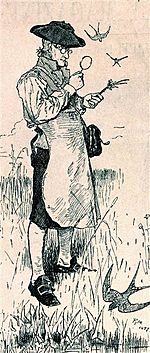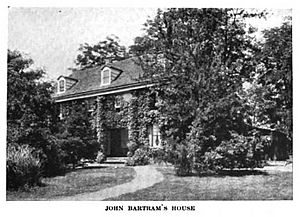John Bartram facts for kids
Quick facts for kids
John Bartram
|
|
|---|---|

John Bartram by Howard Pyle
|
|
| Born | March 23, 1699 |
| Died | September 22, 1777 (aged 78) Philadelphia, Pennsylvania Colony
|
| Resting place | Darby Friends Cemetery, Darby, Pennsylvania |
| Nationality | American (USA) |
| Citizenship | English colonial |
| Scientific career | |
| Fields | botanist |
| Signature | |
 |
|
John Bartram (born March 23, 1699 – died September 22, 1777) was an amazing plant expert, gardener, and explorer from early America. He lived and worked mostly in Philadelphia, Pennsylvania. A famous Swedish botanist named Carl Linnaeus even called him the "greatest natural botanist in the world"!
John Bartram loved sharing plants and seeds from North America with other scientists in England and Europe. In 1728, he started a special place called Bartram's Garden on his farm. This garden, located in Kingsessing (now part of Philadelphia), is thought to be the very first public plant garden in the United States. His family kept the garden going until 1850. Today, it's still open and is a National Historic Landmark.
Contents
Early Life and Learning
John Bartram was born on March 23, 1699, into a Quaker farming family. They lived near Philadelphia in colonial Darby, Pennsylvania. He thought of himself as a simple farmer and didn't have much formal schooling.
However, John was always very interested in medicine and plants that could be used as medicine. He read many books to learn more. He started his plant journey by growing interesting plants in a small part of his farm. Later, he connected with European plant experts and gardeners. This hobby soon grew into a successful business.
Exploring and Collecting Plants
John Bartram began traveling a lot across the eastern American colonies. He wanted to study and collect different plants.
In 1743, he visited western New York and the northern shores of Lake Ontario. He wrote a book about his travels and what he saw. Later, in the winter of 1765-1766, he explored East Florida, which was a British colony at the time. He also wrote about this trip. John even visited areas along the Ohio River, west of the Appalachian Mountains.
Many of the plants he found were sent to collectors in Europe. In return, these collectors sent him books and tools for his work.
Father of American Botany
John Bartram is sometimes called the "father of American botany." He was one of the first people in North America to use the plant classification system developed by Carl Linnaeus. He sent plant samples to Linnaeus and other important botanists like Johann Jacob Dillenius and Laurens Theodorus Gronovius. He also helped Linnaeus's student, Pehr Kalm, during his long plant-collecting trip to North America.
Other British colonists helped Bartram with his collecting. For example, during a trip through the Carolinas, Georgia, and Florida, Dr. David Yeats, a colonial secretary, helped him in British East Florida.
Bartram's Garden: A Special Place
Around 1728, John Bartram created an 8-acre (32,000 m2) plant garden in Kingsessing. It was on the west bank of the Schuylkill River, about 3 miles (5 km) from the center of Philadelphia. This place, known as Bartram's Garden, is often called the first true plant collection in North America. It became a National Historic Landmark in 1960.
In 1743, John Bartram also helped start the American Philosophical Society in Philadelphia with Benjamin Franklin. This group supported scientific studies and new ideas.
Connecting with Other Plant Experts
John Bartram was very important for sending seeds from the New World to gardeners in Europe. Many North American trees and flowers were first grown in Europe because of him. Around 1733, his work got a big boost when he teamed up with an English merchant named Peter Collinson. Collinson also loved plants and was a fellow Quaker. He was part of the Royal Society and knew its president, Sir Hans Sloane.
Collinson shared Bartram's new plants with his friends and other gardeners. Early collections from Bartram went to important people like Lord Petre and Philip Miller at the Chelsea Physic Garden. In the 1730s, Robert James Petre was the top collector of North American trees and shrubs in Europe. After Petre died in 1743, Collinson became Bartram's main contact in London.
Bartram's Boxes
"Bartram's Boxes" became famous. These boxes were regularly sent to Peter Collinson every autumn. They were then given out in England to many clients, including the Duke of Argyll and famous nursery owners. The boxes usually held 100 or more types of seeds. Sometimes they also included dried plant samples and interesting natural items. Sending live plants was harder and more expensive, so those were saved for Collinson and a few special friends.
In 1765, after Collinson and Benjamin Franklin spoke up for him in London, King George III gave Bartram a special job. He became the King's Botanist for North America, earning £50 a year. He held this job until he died. In this role, Bartram also sent his seeds and plants to the royal collection at Kew Gardens. He also sent seeds to the plant gardens at Oxford and Edinburgh universities. In 1769, he was chosen as a foreign member of the Royal Swedish Academy of Sciences in Stockholm.
John Bartram passed away on September 22, 1777. He was buried at the Darby Friends Cemetery in Darby, Pennsylvania.
Legacy and Honors
Most of John Bartram's many plant discoveries were named by other botanists in Europe. He is remembered today for finding and introducing many North American flowering trees and shrubs. These include different kinds of kalmia, rhododendron, and magnolia. He also brought the Dionaea muscipulia, or Venus flytrap, into cultivation.
One of his most famous discoveries was the Franklin tree, Franklinia alatamaha. He found this tree in southeastern Georgia in 1765. His son, William Bartram, later named it.
A type of moss, Bartramia, was named after him. So were other plants like the North American serviceberry, Amelanchier bartramiana, and the subtropical tree Commersonia bartramia. This tree grows in Australia, Vanuatu, and Malaysia.
John Bartram High School in Philadelphia is also named after him. His garden, Bartram's Garden, is a National Historic Landmark.
Family Life
John Bartram was married twice. His first wife was Mary Maris (who died in 1727). They had two sons, Richard and Isaac. After she passed away, he married Ann Mendenhall (1703–1789) in 1729. Together, they had five boys and four girls.
His third son, William Bartram (1739–1823), became a famous botanist, artist, and bird expert himself. William wrote an important book called Travels Through North & South Carolina, Georgia, East & West Florida…, which was published in 1791.
After the American Revolution, John Bartram's sons, John Bartram, Jr., and William Bartram, continued the family plant business. Three generations of the Bartram family kept the botanic garden running and growing. Bartram's Garden was the main plant garden in Philadelphia until the last Bartram family members sold it in 1850.
See also
 In Spanish: John Bartram para niños
In Spanish: John Bartram para niños


